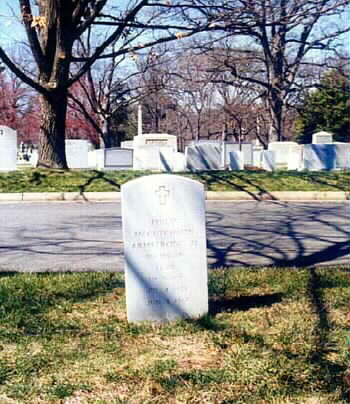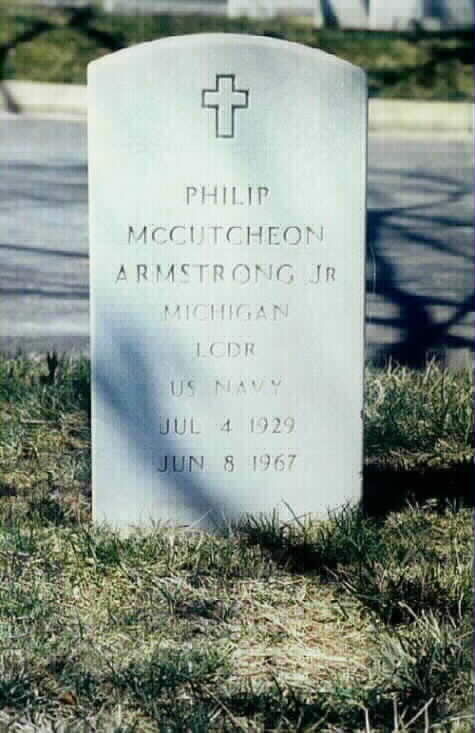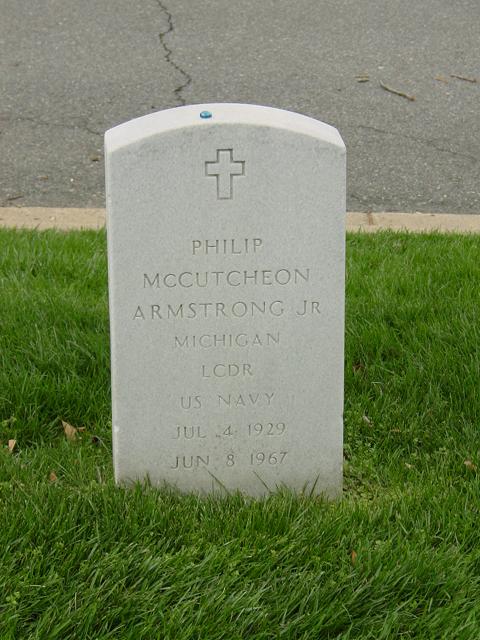Commander Armstrong was killed-in-action while serving as Executive Officer of the USS Liberty, which was bombed by Israeli planes June 8, 1967 while monitoring radar-radio traffic during Israeli-Arab War in Middle East.
Thirteen other members of the crew were buried in a common grave as they were individually unidentifiable.
The Commander was born on 4 July 1929 at Detroit, Michigan, and had been on active duty since 5 June 1953. His wife Marie Kearney Armstrong, of Virginia Beach, Virginia, died in 1988 of cancer.
He was mortally wounded near the bridge of Liberty while attempting to extinguish a large fire. He died about 4 hours later in the battle dressing station. He posthumously received the Navy Cross for heroism during battle.
Commander Armstrong was buried in Arlington National Cemetery, Section 3, Grave 2096-X, with military honors.
ARMSTRONG, PHILIP McCUTCHEON, JR.
Citation:
The President of the United States takes pride in presenting the Navy Cross (Posthumously) to Philip McCutcheon Armstrong, Jr. (569825/1100), Lieutenant Commander, U.S. Navy, for extraordinary heroism in connection with an armed attack on the U.S.S. LIBERTY (AGTR-5) in the Eastern Mediterranean, on 8 June 1967.
During the early afternoon hours, the U.S.S. LIBERTY was attacked without warning by jet fighter aircraft and three motor torpedo boats.
Subjected to intense incendiary, machine-gun, and rocket fire, and placed in extreme jeopardy by a torpedo hit below the waterline on the starboard side, the U.S.S. LIBERTY sustained numerous personnel casualties and severe structural damage. Serving as Executive Officer, Lieutenant Commander Armstrong was on the bridge when the first strafing attack occurred. A large fire erupted in the vicinity of two 55-gallon gasoline drums, creating the grave danger that the drums might explode and cause a widespread conflagration. Lieutenant Commander Armstrong fearlessly exposed himself to overwhelmingly accurate rocket and machine-gun fire while proceeding to jettison the gasoline drums and organizing a party of men to extinguish the blazing lifeboats nearby. At this time, he received multiple injuries which proved to be fatal a few hours after the attack terminated.
By his aggressiveness, composure under fire, and inspiring leadership, Lieutenant Commander Armstrong upheld the highest traditions of the United States Naval Service.
Authority: Navy Department Board of Decorations and Medals


Michael Robert Patterson was born in Arlington and is the son of a former officer of the US Army. So it was no wonder that sooner or later his interests drew him to American history and especially to American military history. Many of his articles can be found on renowned portals like the New York Times, Washingtonpost or Wikipedia.
Reviewed by: Michael Howard

